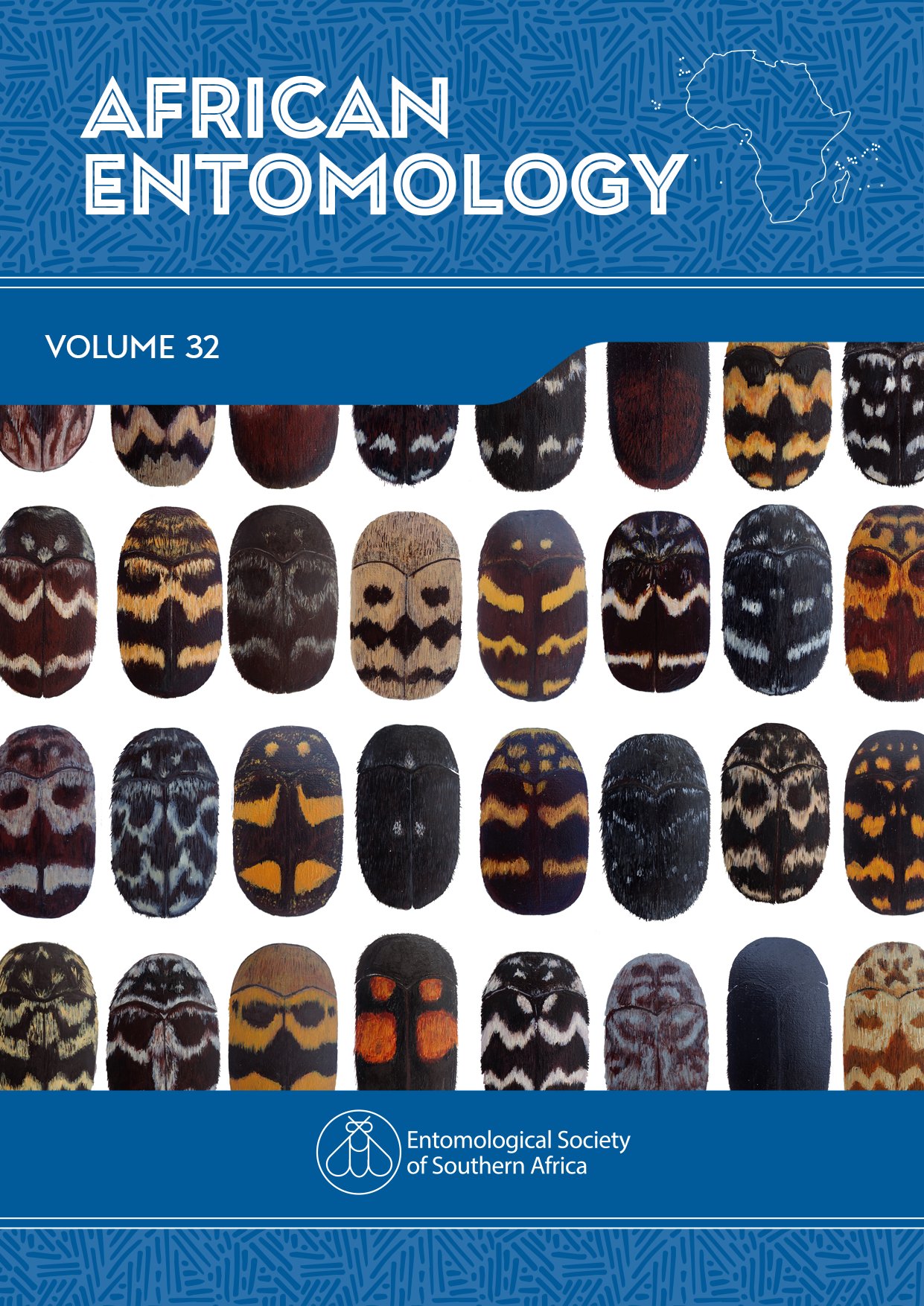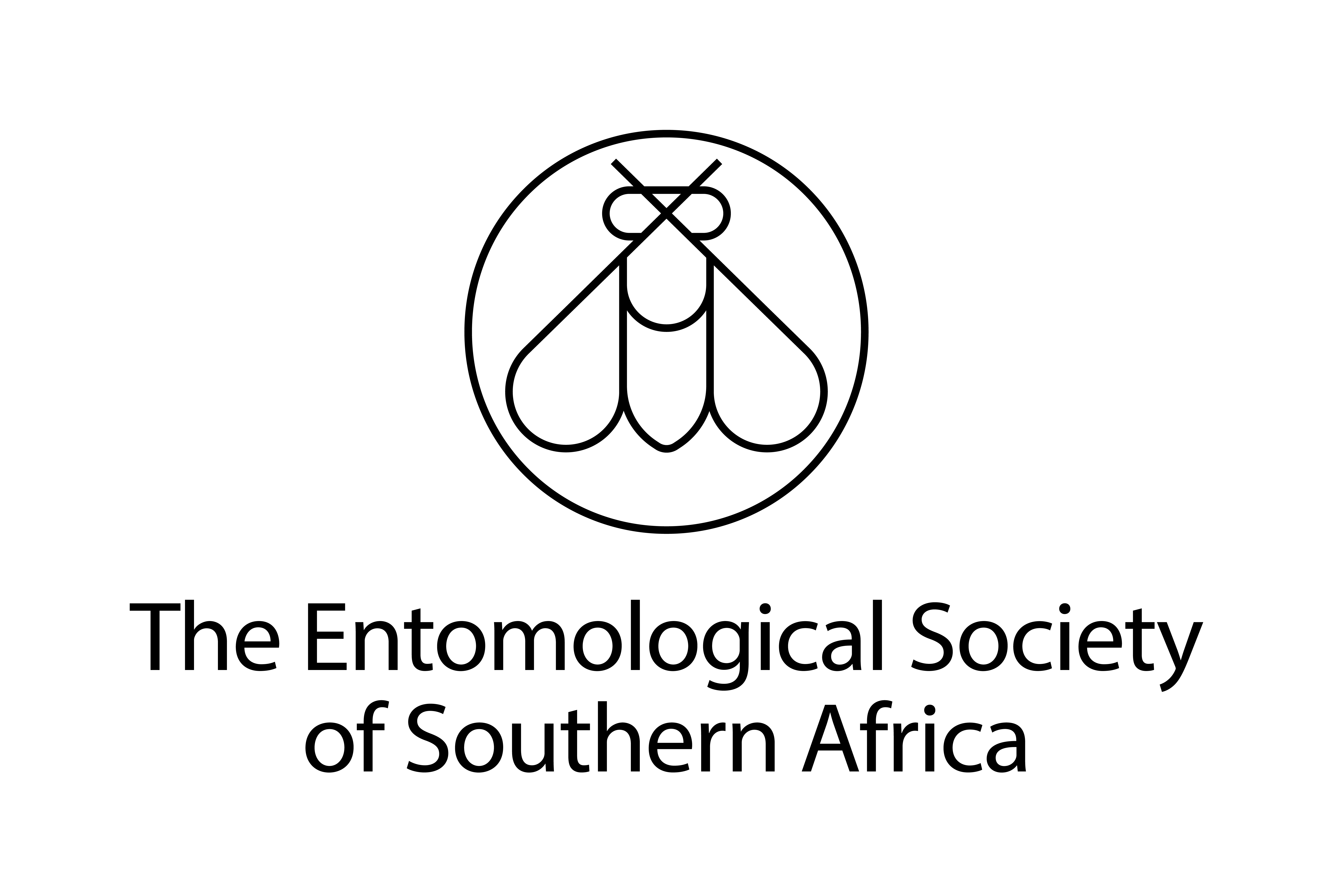The effect of permanent protective netting on insect pest prevalence in citrus orchards in South Africa
DOI:
https://doi.org/10.17159/2254-8854/2024/a17244Keywords:
citrus thrips, citrus mealybug, false codling moth, IPM, mediterranean fruit fly, netted orchards, red scaleAbstract
The use of protective netting is becoming an increasingly popular practice in the citrus industry in South Africa. However, data on its effects on biotic factors, particularly insect pests, are limited. This study focused on the effect nets have on key citrus pests in the Eastern Cape province. Orchards under nets and open orchards, of similar cultivars, ages and management practices, were monitored at several sites over two seasons for pest infestation and damage. Weekly monitoring was conducted for Thaumatotibia leucotreta infestation. Other pests were monitored either monthly or once a season. During the first season, T. leucotreta infestation was higher in orchards under nets, probably because, unlike the open orchards, the nets provided protection for the existing high levels of T. leucotreta. No T. leucotreta infestation was recorded in both orchard types in 2019. This was due to generally lower than usual pest abundance and dramatically improved area-wide management of T. leucotreta. Pheromone traps were used to monitor T. leucotreta males, including sterile moths used in a sterile insect technique programme. Although higher catches of wild T. leucotreta moths were recorded in orchards under nets, so too were there higher numbers of sterile moths and a higher ratio of sterile to wild moths, indicating the potential for better pest suppression for orchards under nets. Various other key pests were monitored during this time, with variable results for each species. Pests that were elevated under nets include Planococcus citri and Aonidiella aurantii. Pests that seemed to be lower under nets were Ceratitis capitata and Scirtothrips aurantii. Nets had no effect on Empoasca distinguenda, Penthimiola bella and Eriophyes sheldoni. These differences in pest levels in netted and open orchards trigger an important debate on whether nets are beneficial for or detrimental to the successful implementation of an integrated pest management programme.
Downloads
References
Alaphlippe A, Capoweiz Y, Severac G, Simon S, Saudreau M, Caruso S, Vergnani S. 2016. Codling moth exclusion netting: an overview of French and Italian experiences. IOBC-WPRS Bulletin. 112:31–35.
Allen RG, Pereira LS, Raes D, Smith M. 1998. Crop evapotranspiration. Guidelines for computing crop water requirements. FAO Irrigation and Drainage Paper. No. 56.
Bastias RM, Manfrini L, Grappadelli LC. 2012. Exploring the potential use of photo-selective nets for fruit growth regulation in apples. Chilean Journal of Agricultural Research. 72(2):224–231.
https://doi.org/10.4067/S0718-58392012000200010.
Bates D, Machler M, Bolker B, Walker S. 2015. Fitting linear mixed-effects models using lme4. Journal of Statistical Software. 67(1):1–48. https://doi.org/10.18637/jss.v067.i01
Bedford ECG. 1998. Part 1: Introduction. In: Bedford ECG, Van Den Berg MA, De Villiers EA (Eds). Citrus pests in the Republic of South Africa. 2nd edition. Agricultural Research Council. Republic of South Africa. pp 1–7.
Bedford ECG. 1998. Red Scale, Aonidiella aurantia (Maskell). In: Bedford ECG, Van Den Berg MA, De Villiers EA. (Eds). Citrus pests in the Republic of South Africa. 2nd edition. Agricultural research council. Republic of South Africa. pp132–144.
Brooks ME, Kristensen K, van Benthem KJ, Magnusson A, Berg CW, Nielsen A, Skaug HJ, Mächler M, Bolker B. 2017. glmmTMB balances speed and flexibility among packages for zero-inflated generalised linear mixed modelling. The R Journal. 9(2):378–400.
https://doi.org/10.32614/RJ-2017-066
Candian V, Pansa MG, Santoro K, Spadaro D, Tavella L, Tedeschi, R. 2020. Photoselective exclusion netting in apple orchards: effectiveness against pests and impact on beneficial arthropods, fungal disease and fruit quality. Pest Management Science. 76(1):1–9. https://doi.org/10.1002/ps.5491
Carroll DP. 1980. Biological notes on the spiders of some citrus groves in central and Southern California. Entomological News. 91(5):147–154.
CBS Expert Panel. 2013. Response to EFSA Panel on Plant Health, 2013-Draft Scientific Opinion on the risk of Phyllosticta citricarpa (Guignardia citricarpa) for the EU territory with identification and evaluation of risk reduction options.
Chouinard G, Firlej A, Cormier D. 2016. Going beyond sprays and killing agents: Exclusion, sterilization and disruption for insect pest control in pome and stone fruit orchards. Scientia Horticulturae (Amsterdam). 208:13–27. https://doi.org/10.1016/j.scienta.2016.03.014
Dippenaar-Schoeman AS, Van den Berg AM, Haddad CR, Lyle R. 2013. Current knowledge of spiders in South African agroecosystems (Arachnida, Araneae). Transactions of the Royal Society of South Africa. 68(1):57–74. https://doi.org/10.1080/0035919X.2012.755136
Grafton-Cardwell B, Eller A, O’Connell N. 1995. Integrated citrus thrips control reduces secondary pests. California Agriculture. 49(2):23–28. https://doi.org/10.3733/ca.v049n02p23
Grossiord C, Buckley TN, Cernusak LA, Novick KA, Poulter B, Siegwolf RTW, Sperry JS, McDowell NG. 2020. Plant responses to rising vapor pressure deficit. New Phytologist. 226(6):1550–1566.
https://doi.org/10.1111/nph.16485
Grout TG. 2019. Orchard Inspection. In: Citrus Research International Integrated Production Guidelines Volume III, Integrated Pest and Disease Management, Chap. 2: Supporting Information for IPM, Part 5. Nelspruit: Citrus Research International. pp 1–5.
Grout TG, Moore SD. 2015. In: Prinsloo GL, Uys VM (eds.), Insects of cultivated plants and natural pastures in Southern Africa. Pretoria: Entomological Society of Southern Africa. pp 447–501.
Grout TG, Richards GI. 1992a. Euseius addoensis addoensis, an effective predator of citrus thrips, Scirothrips aurantii in the Eastern Cape Province of South Africa. Experimental and Applied Acarology. 15(1):1–13. https://doi.org/10.1007/BF01193963
Grout TG, Richards GI. 1992b. Susceptibility of Euseius addoensis addoensis (Acari: Phytoseiidae) to field-weathered residues of insecticides used on citrus. Experimental and Applied Acarology. 15(3):199–204. https://doi.org/10.1007/BF01195791
Grout TG, Richards GI, Stephen PR. 1996. Further non-target effects of citrus pesticides on Euseius addoensis and Euseius citri (Acari: Phytoseiidae). Experimental and Applied Acarology. 21:171–177.
Haddad CR, Vink CJ. 2016. First record and potential range of invasive Badumna longinqua in South Africa. In: Dippenaar-Schoeman A, Lyle R, Haddad C (Eds), SANSA NEWS, Feedback on congress – 20th International Congress of Arachnology 2016. 26:1–15.
Haddad CR. 2003. Spider ecology in pistachio orchards in South Africa. Unpublished MSc thesis, University of the Free State, South Africa.
Hardy S, Khurshid T. 2007. Calculating heat units for citrus. NSW Department of Primary Industries, Primefacts. 749:1–3.
Hardy S, Khurshid T. 2021. Calculating heat units for citrus. NSW Department of Primary Industries, Primefacts. 749:1–4.
Hofmeyr JH, Carpenter JE, Bloem S. 2005. Developing the sterile insect technique for Cryptophlebia leucotreta (Lepidoptera: Tortricidae): Influence of radiation dose and release ratio on fruit damage and population growth in field cages. Journal of Economic Entomology. 98(6):1924–1929. https://doi.org/10.1093/jee/98.6.1924
Hofmeyr JH, Carpenter JE, Bloem S, Slabbert JP, Hofmeyr M, Groenewald SS. 2015. Development of the Sterile Insect Technique to suppress false codling moth Thaumatotibia leucotreta (Lepidoptera: Tortricidae) in Citrus Fruit: Research to implementation (Part1). African Entomology. 23(1):180–186.
https://doi.org/10.4001/003.023.0112
Hofmeyr JH, Hofmeyr M, Carpenter JE, Bloem S, Slabbert JP. 2016. Sterile insect releases for control of Thaumatotibia leucotreta (Lepidoptera: Tortricidae): an assessment on semi-commercial scale. African Entomology. 24(1):80–89. https://doi.org/10.4001/003.024.0080.
Jandricic SE, Schmidt D, Bryant G, Frank SD. 2016. Non-consumptive predator effects on a primary greenhouse pest: Predatory mite harassment reduces western flower thrips abundance and plant damage. Biological Control. 95:5–12. https://doi.org/10.1016/j.biocontrol.2015.12.012
Lloyd A, Hamacek E, George A, Nissen R, Waite G. 2005. Evaluation of exclusion netting for insect pest control and fruit quality enhancement in tree crops. Proceedings IS on Horticulture In Asian-Pacific Region. Acta Horticulturae. (694):253–258.
https://doi.org/10.17660/ActaHortic.2005.694.41
Mahmood A, Hu Y, Tanny J, Asante EA. 2018. Effects of shading and insect-proof screens on crop microclimate and production: A review of recent advances. Scientia Horticulturae. 241:241–251.
https://doi.org/10.1016/j.scienta.2018.06.078
Manrakhan A. 2023. Fruit Fly. In: Grout TG (Ed.), Chapter 3: Specific pests. Vol 3, Part 4. Nelspruit: Citrus Research International, South Africa. pp 1–12. http://www.citrusres.com
Manja K, Aoun M. 2019. The use of nets for tree fruit crops and their impact on the production: A review. Scientia Horticultura. 246:110–122. https://doi.org/10.1016/j.scienta.2018.10.050.
Marsberg T, Peyper M, Moore S. 2021. Spinning a new story in citrus, A first record of two spider species. South African Fruit Journal: Technology. (Aug–Sept):95–97.
Marshall AT, Beers EH. 2021. Efficacy and nontarget effects of net exclusion enclosures on apple pest management. Journal of Economic Entomology. 114(4):1681–1689. https://doi.org/10.1093/jee/toab094
Moore SD. 2013. Leafhoppers & Planthoppers. In: Grout TG. (Ed), Integrated Production guidelines, chapter 3: Specific pests. Nelspruit: Citrus Research International, South Africa. pp 1–3.
Moore SD. 2021. Biological Control of a Phytosanitary Pest (Thaumatotibia leucotreta): A case study. International Journal of Environmental Research and Public Health. 18(3):1198.
https://doi.org/10.3390/ijerph18031198
Moore SD. 2022. Moths & butterflies: false codling moth (Part 9.4). In: Grout TG. (Ed), Integrated production guidelines, Vol. 3. Nelspruit: Citrus Research International, South Africa. pp 1–9.
Moore SD, Kirkman W, Hattingh V. 2016. Verification of inspection standards and efficacy of a systems approach for Thaumatotibia leucotreta (Lepidoptera: Tortricidae) for export citrus from South Africa. Journal of Economic Entomology. 109(4):1564–1570.
https://doi.org/10.1093/jee/tow139
Mupambi G, Anthony BM, Layne DR, Musacchi S, Serra S, Schmidt T, Kalcsits LA. 2018. The influence of protective netting on tree physiology and fruit quality of apple: a review. Scientia Horticulturae (Amsterdam). 236:60–72. https://doi.org/10.1016/j.scienta.2018.03.014
Prins M. 2018. The impact of shade netting on the microclimate of a citrus orchard and the tree’s physiology. MSc Thesis, Stellenbsoch University, South Africa.
Rigden P. 2008. To net or not to net. Queensland Department of Primary Industries and Fisheries, Queensland. pp 1–64.
Rypstra AL, Buddle CM. 2013. Spider silk reduces insect herbivory. Biology Letters. 9(1):1–4. https://doi.org/10.1098/rsbl.2012.0948
Sauphanor B, Severac G, Maugin S, Toubon JF, Capowiez Y. Exclusion netting may alter reproduction of the codling moth (Cydia pomonella) and prevent associated fruit damage to apple orchards. Entomologia Experimentalis et Applicata. 2012;145(2):1–9.
https://doi.org/10.1111/j.1570-7458.2012.01320.x
Shahak Y, Ratner K, Zur N, Offir Y, Matan E, Yehezkel H, Messika Y, Posalski I, Ben-Yakir D. 2009. Photoselective netting: an emerging approach in protected agriculture. Acta Horticulturae. (807):79–84. https://doi.org/10.17660/ActaHortic.2009.807.7
Simó M, Laborda A, Núnez M, Brescovit AD. 2015. First records of the invasive spider Badumna longinqua (L. Koch) (Desidae) in southern Brazil with notes on the habitats and the species dispersion. Checklist, Biotaxa. 11(1):1533–1536. https://doi.org/10.15560/11.1.1533
Walzer A, Schausberger P. 2009. Non-consumptive effects of predatory mites on thrips and its host plant. Oikos. 118(6):934–940.
https://doi.org/10.1111/j.1600-0706.2008.17299.x
Wilson K, Grzywacz D, Curcic I, Scoates F, Harper K, Rice A, Paul N, Dillon A. 2020. A novel formulation technology for baculoviruses protects biopesticide from degradation by ultraviolet radiation. Nature Research, Scientific Reports. 10, 13301.
Downloads
Published
Issue
Section
License
Copyright (c) 2024 Tamryn Marsberg, Mellissa Peyper, Wayne Kirkman, Sean Moore, Guy Sutton

This work is licensed under a Creative Commons Attribution 4.0 International License.




.png)